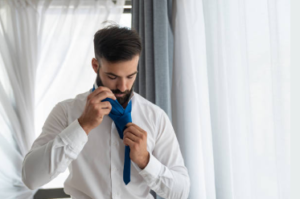So, your company just announced a switch to business casual dress code and you’re not quite sure what that means. This guide will give you the basics for looking stylish and professional as you settle into the new normal. Whether you’re in the office every day or only occasionally, having a go-to business casual wardrobe will make getting ready in the morning a breeze so you can focus on the important stuff, like your first coffee.
Defining Business Casual: What Exactly Does It Mean?
Business casual is a broad term that encompasses a range of styles, but here are some guidelines:
Acceptable Attire
Tops: Button-down shirts, blouses, sweaters, cardigans, polos. Avoid anything too casual like t-shirts, crop tops or spaghetti straps.
Bottoms: Slacks, khakis, skirts (knee-length or longer), dresses. Jeans and shorts are typically too casual for work.
Shoes: Loafers, flats, low heels (2 inches or less), oxfords, boots. Flip flops and sneakers are not office-appropriate.
Accessories: A simple belt, scarf, tie or blazer can help polish an outfit. Keep jewelry and fragrances minimal and muted.
Dressing for Your Company Culture
The key is to match the level of formality in your workplace. If your coworkers wear polos and khakis, that’s probably a safe bet for you too. But if everyone is in button-downs and slacks, you’ll want to dress on the more formal end of business casual. Keep your outfit neat, pressed and avoid wrinkles. Following these tips will ensure you make a great first impression at your new job!
Business Casual Attire for Men and Women
Shirts
Stick with long-sleeved button-down shirts, polos, or casual blazers over a nice t-shirt. Avoid anything too casual like short sleeves or t-shirts with graphics.
Pants
Slacks, khakis, or corduroys in solid colors or simple patterns are good options. Jeans, shorts, and sweatpants are a no-go.
Shoes
Loafers, oxfords, or simple lace-up shoes with a minimal heel are stylish yet professional. Avoid sneakers, sandals, boots, or anything too flashy.
Tops
Blouses, shells, cardigans, and blazers pair well with skirts or pants. Avoid overly casual tops like t-shirts, tank tops, shortsleeves or anything too embellished.
Bottoms
Slacks, skirts just above the knee, and knee-length or longer dresses are stylish options. Avoid anything too tight, short, frilly or made of denim or knit fabrics.
Shoes
Loafers, ballet flats, low or mid-heel pumps, and knee-high boots are stylish yet professional. Avoid anything too flashy, open-toed or with a platform.
. With these tips, you’ll master the business casual dress code in no time!
Dressing for Success: Tips to Nail Business Casual
Business casual attire can be tricky to navigate, but following a few tips will ensure you’re dressing for success.
Focus on Fit and Quality
Invest in high-quality, well-fitting staples like button-down shirts, blouses, slacks, and khakis. Ill-fitting, wrinkled clothing looks unprofessional no matter how much you paid. Stick to solid colors or simple patterns in neutral, versatile shades that pair well and can be mixed and matched.
Dress It Up or Down
Have a couple of layers or accessories on hand to adapt your outfit for different occasions. Add a blazer or cardigan for meetings or dress it down by removing layers for a more casual day. Simple jewelry, a patterned scarf, or a statement belt are easy ways to change up an outfit.
Mind the Details
Crisp, pressed clothing and polished shoes show you pay attention to detail. Make sure any exposed undergarments or straps are not visible under your clothing. Well-groomed hair and minimal fragrance are also important.
When in Doubt, Overdress
If you’re unsure of the formality for an event, it’s always better to be overdressed than underdressed. You can remove a tie or blazer, but you can’t add one if you need it. It’s a sign of respect to dress in professional, business-appropriate attire for work events.
Following these useful tips for styling, fit, and presentation will ensure you’re dressing appropriately for any business casual occasion. When you look pulled together, you’ll feel more confident and ready to focus on work.
Conclusion
So there you have it, your guide to navigating the business casual dress code at your new office. Gone are the days of stuffy suits and ties, you can now express your personal style at work within reason. Focus on looking put together and professional, stick to solid colors and patterns, and make sure everything is clean and pressed. Most importantly, check with your specific office policy to understand their guidelines. Business casual opens up so many options to be comfortable yet stylish at your job. Use this opportunity to develop your own work wardrobe that makes you feel confident and motivated. With the right balance of casual and professional, you’ll be dressing for success in no time.








5 thoughts on “Business Casual 101: Your Guide to the New Office Norm”